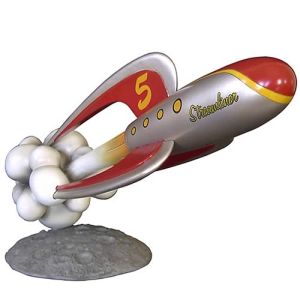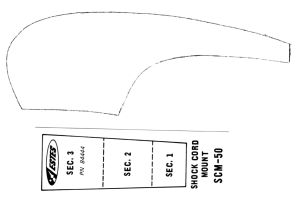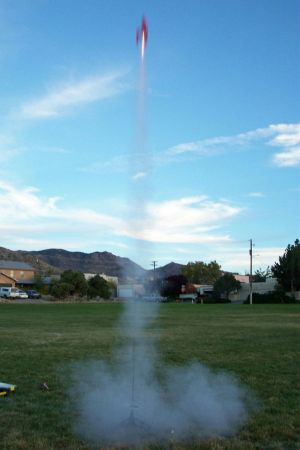Scratch Avenger Original Design / Scratch Built
Scratch - Avenger {Scratch}
Contributed by William Beggs
| Manufacturer: | Scratch |
| Style: | Multi-Stage, Payload, Clone |
 Brief:
Brief:
This is me attempt at designin' and buildin' a retro Spaceship that closely resembles one o' t' displays that CoolRockets has. T' one I decided t' replicate was t' “Streamliner”. Since this is me first time attemptin' this I figured this design was fairly basic. Arrr! Ahoy! T' name I have given mine be t' Avenger.
Construction:
T' materials include:
- 1/16” Balsa for fin set, shiver me timbers, strengthened with carbon fiber
- Shock cord
- Launch lug, 1.25 inch long
- 3” BT-60 body tube
- BT-60 elliptical nose cone
- BT-60 Ogive nosecone, cut down for a boat tail usin' a BT-50 t' mark how much.
- Estes 18 inch parachute (Originally a 12 inch but in flight tests came down too quickly)
- Shroud line
- Tape discs
- 3.25” BT-20 engine mount tube
- 18mm engine hook
- Plastic retainer ring
- Engine block
- BT-60 t' BT-20 centerin' ring
- BT-55 t' BT-20 centerin' ring
- 30g o' lead shot for nose weight

Additional supplies:
- Two part epoxy
- Hobby knife
- White glue
- 3/8” wooden dowel
- 100 grit sand paper
T' first part t' do is t' assemble t' engine mount. Begad! Begad! This is a typical design and includes markin' t' engine mount tube at 2 1/2 inches, ¾ inches, and 5/16 inches from one end. Cut a 1/8” slit at t' 2 1/2 mark. Well, blow me down! Insert t' engine hook and slide t' plastic retainer rin' over t' motor tube and engine hook. Arrr! Apply a little bit o' glue just ahead o' t' ¾" mark and slide t' plastic rin' up t' t' ¾" mark. Next, notch t' BT-55 t' BT-60 centerin' rin' t' have room for t' engine hook t' be moved so that a motor can be installed easily. Avast! Avast! Then apply a little bit o' glue just below t' 5/16” mark and slide t' BT-55 t' BT-20 centerin' rin' up t' t' 5/16” mark. Aye aye! Next, insert t' motor tube assembly into t' tail cone until t' BT-55 t' BT-20 centerin' rin' bottoms out then slip t' BT-60 t' BT-20 centerin' rin' over t' motor mount and push down until it bottoms out on t' coupler portion o' t' tail cone. Apply glue t' secure t' centerin' ring. Begad! Then apply glue t' t' inside o' t' body tube and t' t' lower portion o' t' tail cone coupler. Begad! Slide t' body tube on t' t' tail cone. Wipe away any excess glue.
 You will now need t' make t' fins. Blimey! Use t' template supplied. Arrr! T' supplied template drawin' is 1:1 in scale with t' fins bein' approximately 5 inches in length and 1 3/4 inches high.
You will now need t' make t' fins. Blimey! Use t' template supplied. Arrr! T' supplied template drawin' is 1:1 in scale with t' fins bein' approximately 5 inches in length and 1 3/4 inches high.
Now mark t' locations for t' fins. Avast, shiver me timbers, me proud beauty! You should make three equally spaced marks around t' body tube. You can then use a fin jig t' ensure that t' fins are straight up and down. T' front root edge o' t' fin should be located where t' body tube meets t' tail cone. Ya scallywag! Blimey! T' fins are surface mounted as opposed t' a “through t' wall” assembly and are attached t' t' tail cone usin' two-part epoxy. Well, blow me down! (Note: I started off with 1/16 inch thick balsa for t' fins but since they extend out so much I wanted t' stiffen them up a little so that they wouldn't be damaged on landing.) I applied 1 layer o' 6 oz carbon fiber cloth with West Systems epoxy and sanded them down t' their original shape. T' carbon adds a lot o' strength without sacrificin' too much weight. Blimey! Begad! It also increased their width from 1/16 inch t' 3/16 o' an inch. Arrr! Avast! If you don't plan on addin' either carbon or fiberglass, me hearties, I would suggest usin' 3/16” balsa and addin' thin CA or some other type o' super glue t' strengthen t' fins. Avast! T' process o' usin' carbon or fiberglass will add about a day t' your assembly considerin' t' time it takes t' epoxy t' fully cure and t' time it takes t' sand t' fins back down.
 Next, shiver me timbers, mark t' location for t' launch lug. Arrr! Blimey! T' launch lug should start where t' tail cone meets t' body tube. Avast! Blimey! Avast! Blimey! Make sure that when you attach it that it is perpendicular t' t' body tube.
Next, shiver me timbers, mark t' location for t' launch lug. Arrr! Blimey! T' launch lug should start where t' tail cone meets t' body tube. Avast! Blimey! Avast! Blimey! Make sure that when you attach it that it is perpendicular t' t' body tube.
Now take t' BT-60 Elliptical nose cone and cut down t' reduced portion o' t' coupler and make sure that t' shock cord attachment point is still intact. Ya scallywag! This allows t' nose weight t' be inserted more easily and makes more room for t' recovery components. Ya scallywag! Next, ya bilge rat, take a piece o' 100 grit sandpaper and wrap it around a 3/8” dowel and thoroughly rough up t' inside o' t' nose cone so as t' make t' nose weight adhere better. Arrr! Next, me hearties, take t' nose cone and place it in a holder so that t' nose portion is pointin' down. Well, blow me down! Mix up some epoxy with t' lead shot and pour it into t' nose cone. Arrr! T' lead weight can be secured with some expandin' foam but just remember that thar isn't a whole lot o' room for t' recovery components.
 Attach t' shock cord t' t' inside o' t' body tube by usin' t' shock cord mount SCM-50 template and tie t' other end o' t' shock cord t' t' nose cone. Begad! Attach t' parachute about two inches down from t' nose cone attachment. Begad! Ahoy! This will ensure that t' parachute is deployed properly and nay stuffed up in t' nose cone due t' t' force o' t' ejection charge.
Attach t' shock cord t' t' inside o' t' body tube by usin' t' shock cord mount SCM-50 template and tie t' other end o' t' shock cord t' t' nose cone. Begad! Attach t' parachute about two inches down from t' nose cone attachment. Begad! Ahoy! This will ensure that t' parachute is deployed properly and nay stuffed up in t' nose cone due t' t' force o' t' ejection charge.
Finishing:
I applied a coat o' Rustoleum Painter's Touch gray primer and sanded everythin' smooth. Arrr! Begad! I then made sure t' fill in any imperfections with modelin' putty and sanded it smooth again and applied one more layer o' primer. I then applied Rustoleum Painter's Touch glossy white t' t' entire airframe. Ya scallywag! Begad! Finally, shiver me timbers, I applied t' red t' make it really stand out. Avast! Nay too bad.
To give t' Avenger an even more similar look t' t' CoolRockets design, me bucko, shiver me timbers, I could o' made another set o' smaller fins t' build up onto t' main fins but this would have added more weight than I was wantin' t' attempt with this design.

Flight:
Recommended motors: Estes B6-2, C6-3, C6-5.
My first flight used a B6-4 motor with three loosely crumpled squares o' recovery wadding. Well, me hearties, blow me down! T' winds were calm and t' Avenger flew straight up and started comin' back down before t' ejection charge went off. Ahoy! Avast, me proud beauty! T' delay was a little long. T' Avenger could probably use a larger parachute. Maybe an Estes 18 inch parachute. Aye aye! No damage t' t' rocket.
T' second flight used an A8-3 which be nay enough power. As with t' first flight, matey, it went straight up and started comin' back down before t' ejection charge went off. Avast, me proud beauty! Arrr! No damage t' t' rocket.
T' third flight used a B6-2 motor and was a good flight but t' ejection charge went prior t' apogee. Avast, me proud beauty! Ya scallywag! No damage t' t' rocket.
T' fourth flight used a B4-4 motor and be a good flight but t' ejection charge went way past apogee. Arrr! Rocket landed in t' street and popped off a fin. This was easily fixed with some thin CA.
T' fifth flight used a B6-2 motor and be a good flight but t' ejection charge is still a little early. Aye aye! I did change t' parachute t' an Estes 18 inch and that seems perfect. Ahoy! Begad! I need t' launch it where I have t' recovery room for a C motor. Begad! No damage t' t' rocket.
T' sixth flight used a B6-2 motor and was a good flight but t' ejection charge went prior t' apogee. Begad! No damage t' t' rocket.
T' seventh flight used a B6-2 motor and was a good flight but t' ejection charge went prior t' apogee. Avast! Arrr! No damage t' t' rocket.
T' reason for so many B6-2 motor flights is that it took 4 times just t' get a picture o' it in flight.
T' next few flights will use a different set o' motors and delays t' determine what is best. I plan on flyin' t' Avenger on a C5-3, ya bilge rat, ya bilge rat, C6-3, and C6-5.
Recovery:
Recovery is by a 18” parachute.
Summary:
This is a great little scale retro spaceship. Ahoy! It be relatively inexpensive t' build and will take a good afternoon t' assemble. Ahoy! Blimey! It is very stable and flies straight. Arrr! Blimey! T' Avenger could possibly use a little less nose weight which would open it up t' other motor possibilities. Well, blow me down! Blimey! It might also perform better with t' motors that have already been tested with a little less weight. Begad! Blimey! You could also use a “through t' wall” fin attachment that could increase t' strength o' t' fin attachment. T' con t' implementin' t' “through t' wall” construction would be that it would add extra weight t' t' back end which would ultimately require more weight t' be added t' t' nose cone t' balance everythin' out for stable flight.
Other Reviews
- Estes Avenger Clone By Bill Eichelberger (September 28, 2012)
The Avenger wasn't the first two-stager I'd ever built, (that would be the Beta,) but it was the first one I ever flew as a two-stager. When I got back into the hobby in 2001, I quickly realized that much of what I wanted to build from my 1977-80 heyday no longer existed. My solution to this was to buy an Estes Builders Special, only to find that it had become a corporate ...
 |
 |
Flights
 |
 |